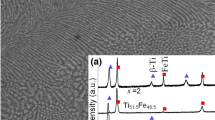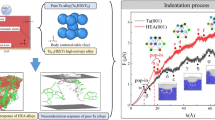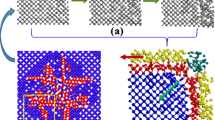Abstract
The effect of the orientation relationship between γ and α2 phases on the mechanical properties and microstructural evolution in duplex full lamellar TiAl alloys is investigated by the nanoindentation technique using molecular dynamics (MD) simulation method. In this paper, we construct separately the Blackburn orientation relationship: ⟨1–10⟩γ∥⟨11–20⟩α2 and {111}γ∥(0001)α2, the Parallel orientation relationship: [010]γ∥[1–210]α2 and (001)γ∥(0001)α2 as well as the Vertical orientation relationship: [001]γ∥[1–210]α2 and (100)γ∥(0001)α2 these three models. The results show that the effect of different orientation relationships cause variability in the fluctuation amplitude and magnitude of force, the accumulation shape and area of surface morphology, the atomic displacement, and the temperature on the substrate during the indentation process. The hardness and the modulus of elasticity for the alloys vary according to the orientation relationships, with the Blackburn orientation relationship having the highest hardness and modulus of elasticity, the Parallel orientation relationship having the lowest modulus of elasticity, and the Vertical orientation relationship having the lowest. The amount of deformation and defect evolution of the substrate during the indentation process are also affected by the orientation relationships, with the Blackburn orientation relationship model producing the most defects, the Vertical orientation relationship the next most, and the Parallel orientation relationship being the least.













Similar content being viewed by others
Data availability
Data will be made available on request.
References
Y.H. Yu, H.C. Kou, Y.C. Wang, M.Y. Jia, X.X. Xu, Z.L. Zhang, Y.R. Wang, J.S. Li, Formation of core-shell-like structure in β-solidified TiAl alloy and its effect on hot workability. Acta Mater. 255, 119036 (2023). https://doi.org/10.1016/j.actamat.2023.119036
W.L. Zhou, C. Shen, X.M. Hua, L. Wang, Y.L. Zhang, F. Li, J.W. Xin, Y.H. Ding, The effect of vanadium on the microstructure and mechanical properties of TiAl alloy fabricated by twin-wire directed energy deposition-arc. Addit. Manuf. 62, 103382 (2023). https://doi.org/10.1016/j.addma.2022.103382
G.M. Zheng, B. Tang, S.K. Zhao, W.Y. Wang, X.F. Chen, L. Zhu, J.S. Li, Evading the strength-ductility trade-off at room temperature and achieving ultrahigh plasticity at 800 °C in a TiAl alloy. Acta Mater. 225, 117585 (2022). https://doi.org/10.1016/j.actamat.2021.117585
Y. Liu, J.S. Li, B. Tang, W.Y. Wang, M.J. Lai, L. Zhu, H.C. Kou, Formation mechanism of γ twins in β-solidified γ-TiAl alloys. J. Mater. Sci. Technol. 105, 164–171 (2022). https://doi.org/10.1016/j.jmst.2021.04.080
Y. Zhang, Y.J. Lee, S. Chang, Y.Y. Chen, Y.C. Bai, J. Zhang, H. Wang, Microstructural modulation of TiAl alloys for controlling ultra-precision machinability. Int. J. Mach. Tools Manuf 174, 103851 (2022). https://doi.org/10.1016/j.ijmachtools.2022.103851
B. Selvarajou, M.H. Jhon, R. Ramanujan, S.S. Quek, Temperature dependent anisotropic mechanical behavior of TiAl based alloys. Int. J. Plasticity 152, 103175 (2022). https://doi.org/10.1016/j.ijplas.2021.103175
R.R. Xu, M.Q. Li, Y.H. Zhao, A review of microstructure control and mechanical performance optimization of γ-TiAl alloys. J. Alloys Compd. (2022). https://doi.org/10.1016/j.jallcom.2022.167611
F. Appel, R. Wagner, Microstructure and deformation of two-phase γ-titanium aluminides. Mater. Sci. Eng. R. Rep. 22(5), 187–268 (1998). https://doi.org/10.1016/S0927-796X(97)00018-1
L.M. Hsiung, T.G. Nieh, Creep deformation of fully lamellar TiAl controlled by the viscous glide of interfacial dislocations. Intermetallics 7(7), 821–827 (1999). https://doi.org/10.1016/S0966-9795(98)00135-6
Z. Liu, Y.R. Zhang, L. Bai, L.H. Jiang, Z.H. Guo, Y.J. Liu, Z.B. Zhao, Q. Zhang, D.Z. Yang, Effects of lamellar α orientation on the mechanical behavior of Ti–6Al–4V alloy manufactured by electron beam directed energy deposition. Mater. Sci. Eng. A 885, 145559 (2023). https://doi.org/10.1016/j.msea.2023.145559
Y.M. Qi, H.M. Xu, T.W. He, M.L. Feng, Effect of crystallographic orientation on mechanical properties of single-crystal CoCrFeMnNi high-entropy alloy. Mater. Sci. Eng. A 814, 141196 (2021). https://doi.org/10.1016/j.msea.2021.141196
F. Wen, J.Q. Chen, S.B. Zhong, Z.X. Zhou, S. Han, H.G. Wei, Y.H. Zhang, W.R. Li, R.G. Guan, Effect of crystal orientations and precipitates on the corrosion behavior of the Al-Cu alloy using single crystals. J. Alloys Compd. 890, 161858 (2022). https://doi.org/10.1016/S1003-6326(22)66065-5
D.-Q. Doan, Effects of crystal orientation and twin boundary distance on mechanical properties of FeNiCrCoCu high-entropy alloy under nanoindentation. Mater. Chem. Phys. 291, 126725 (2022). https://doi.org/10.1016/j.matchemphys.2022.126725
K. Wang, X. Chen, S.Y. Huang, X.Y. Chen, Z.M. Wang, Y. Huang, Diffusion behavior determined by the new n-body potential in highly immiscible W/Cu system through molecular dynamics simulations. J. Mater. Res. Technol. 24, 3731–3745 (2023). https://doi.org/10.1016/j.jmrt.2023.04.068
Z. Fang, Y.H. Feng, Y.D. Yan, Y.Q. Geng, Molecular dynamics simulation study on the effect of crystal orientation on bi-crystal gold nanocrystals in nanoskiving process. J. Manuf. Process. 81, 224–235 (2022). https://doi.org/10.1016/j.jmapro.2022.06.071
A.A. Volinsky, W.W. Gerberich, Nanoindentaion techniques for assessing mechanical reliability at the nanoscale. Microelectron. Eng. 69(2–4), 519–527 (2003). https://doi.org/10.1016/S0167-9317(03)00341-1
J.P. Wang, J.W. Liang, Z.X. Wen, Z.F. Yue, Y. Peng, Unveiling the local deformation behavior of typical microstructures of nickel-based single crystals under nanoindentation. Mech. Mater. 166, 104204 (2022). https://doi.org/10.1016/j.mechmat.2021.104204
S. Plimpton, Fast parallel algorithms for short-range molecular dynamics. J. Comput. Phys. 117(1), 1–19 (1995). https://doi.org/10.1006/jcph.1995.1039
L. Zhang, J.F. Sun, A.H. Ngan, Z.L. Ning, H.B. Fan, Y.J. Huang, Heterogeneity of microstructures in a Cu–Zr based amorphous alloy composite reinforced by crystalline phases. Compos. Part B Eng. 262, 110823 (2023). https://doi.org/10.1016/j.compositesb.2023.110823
M. Blackburn, Some Aspects of Phase Transformations in Titanium Alloys (Boeing Scientific Research Labs., Seattle, 1970), pp.633–642
X.D. Wang, Y.D. Shen, S.X. Song, P. Liu, Q. An, K.M. Reddy, Atomic-scale understanding of the γ/α2 interface in a TiAl alloy. J. Alloys Compd. 846, 156381 (2020). https://doi.org/10.1016/j.jallcom.2020.156381
H. Inui, M.H. Oh, A. Nakamura, M. Yamaguchi, Ordered domains in TiAl coexisting with Ti3Al in the lamellar structure of Ti-rich TiAl compounds. Philos. Mag. A 66(4), 539–555 (1992). https://doi.org/10.1080/01418619208201574
Q.W. Guo, H. Hou, Y. Pan, X.L. Pei, Z. Song, P.K. Liaw, Y.H. Zhao, Hardening-softening of AlO3CoCrFeNi high-entropy alloy under nanoindentation. Mater. Des. (2023). https://doi.org/10.1016/j.matdes.2023.112050
N. Shuichi, Constant temperature molecular dynamics methods. Prog. Theor. Phys. Suppl. 103, 1–46 (1991). https://doi.org/10.1143/PTPS.103.1
Z.Y. Zhao, J.X. Liu, Probing plastic mechanisms in gradient dual-phase high-entropy alloys under nanoindentation. J. Alloys Compd. 946, 169424 (2023). https://doi.org/10.1016/j.jallcom.2023.169424
H.X. Wang, S. Gao, R.K. Kang, X.G. Guo, H.G. Li, Mechanical load-induced atomic-scale deformation evolution and mechanism of SiC polytypes using molecular dynamics simulation. Nanomaterials 12(14), 2489 (2022). https://doi.org/10.3390/nano12142489
L. Verlet, Computer “experiments” on classical fluids. I. Thermodynamical properties of Lennard-Jones molecules. Phys. Rev. 159(1), 98 (1967). https://doi.org/10.1103/PhysRev.159.98
M. Zheng, D.F. Qu, Z.X. Zhu, W.H. Chen, Z. Zhang, Z. Wu, L.J. Wang, X.Z. Ma, Study on nanoscale friction behavior of TiC/Ni composites by molecular dynamics simulations. Coatings 12(8), 1168 (2022). https://doi.org/10.3390/coatings12081168
J.M. Li, Y.H. Huang, Y.Q. Zhou, F.L. Zhu, Role of boron nitride nanosheet coatings on aluminum substrates during the nanoindentation from the atomic perspective. Appl. Surf. Sci. 608, 155126 (2023). https://doi.org/10.1016/j.apsusc.2022.155126
C. Chen, H.T. Li, H.G. Xiang, X.H. Peng, Molecular dynamics simulation on B3-GaN thin films under nanoindentation. Nanomaterials 8(10), 856 (2018). https://doi.org/10.3390/nano8100856
D.P. Hua, W.T. Ye, Q. Jia, Q. Zhou, Q.S. Xia, J.Q. Shi, Y.Y. Deng, H.F. Wang, Molecular dynamics simulation of nanoindentation on amorphous/amorphous nanolaminates. Appl. Surf. Sci. 511, 145545 (2020). https://doi.org/10.1016/j.apsusc.2020.145545
J. Tersoff, Modeling solid-state chemistry: interatomic potentials for multicomponent systems. Phys. Rev. B 39(8), 5566 (1989). https://doi.org/10.1103/PhysRevB.39.5566
Z.P. Hao, R.R. Cui, Y.H. Fan, J.Q. Lin, Diffusion mechanism of tools and simulation in nanoscale cutting the Ni–Fe–Cr series of Nickel-based superalloy. Int. J. Mech. Sci. 150, 625–636 (2019). https://doi.org/10.1016/j.ijmecsci.2018.10.058
M.I. Baskes, Modified embedded-atom potentials for cubic materials and impurities. Phys. Rev. B 46(5), 2727 (1992). https://doi.org/10.1103/PhysRevB.46.2727
Y.-M. Kim, B.-J. Lee, Modified embedded-atom method interatomic potentials for the Ti–C and Ti–N binary systems. Acta Mater. 56(14), 3481–3489 (2008). https://doi.org/10.1016/j.actamat.2008.03.027
Y.-K. Kim, H.-K. Kim, W.-S. Jung, B.-J. Lee, Atomistic modeling of the Ti–Al binary system. Comput. Mater. Sci. 119, 1–8 (2016). https://doi.org/10.1016/j.commatsci.2016.03.038
M.G. Elkhateeb, Y.C. Shin, Molecular dynamics-based cohesive zone representation of Ti6Al4V/TiC composite interface. Mater. Des. 155, 161–169 (2018). https://doi.org/10.1016/j.matdes.2018.05.054
K. Maekawa, A. Itoh, Friction and tool wear in nano-scale machining—a molecular dynamics approach. Wear 188(1–2), 115–122 (1995). https://doi.org/10.1016/0043-1648(95)06633-0
R.C. Feng, Z.H. Shao, S.Z. Yang, H. Cao, H.Y. Li, C.L. Lei, J. Zhang, Material removal behavior of nanoscale shear cutting and extrusion cutting of monocrystalline γ-TiAl alloy. Int. J. Adv. Manuf. Technol. 119(9–10), 6729–6742 (2022). https://doi.org/10.1007/s00170-021-08536-8
Z.W. Chen, X. Wang, V. Bhakhri, F. Giuliani, A. Atkinson, Nanoindentation of porous bulk and thin films of LaO.6SrO.4CoO.2FeO.8O3− δ. Acta Mater. 61(15), 5720–5734 (2013). https://doi.org/10.1016/j.actamat.2013.06.016
Y. He, R.B. Schwarz, A. Migliori, S.H. Whang, Elastic constants of single crystal γ–TiAl. J. Mater. Res. 10(5), 1187–1195 (1995). https://doi.org/10.1557/JMR.1995.1187
S. Xu, Q. Wan, Z.D. Sha, Z.S. Liu, Molecular dynamics simulations of nano-indentation and wear of the γTi-Al alloy. Comput. Mater. Sci. 110, 247–253 (2015). https://doi.org/10.1016/j.commatsci.2015.08.045
W.C. Oliver, G.M. Pharr, An improved technique for determining hardness and elastic modulus using load and displacement sensing indentation experiments. J. Mater. Res. 7(6), 1564–1583 (1992). https://doi.org/10.1557/JMR.1992.1564
Z.Y. Qian, J. Risan, B. Stadnick, G.B. McKenna, Apparent depth-dependent modulus and hardness of polymers by nanoindentation: investigation of surface detection error and pressure effects. J. Polym. Sci. Part B Polym. Phys. 56(5), 414–428 (2018). https://doi.org/10.1002/polb.24554
Y. Song, S.-Y. Tang, J. Xu, O.N. Mryasov, A.J. Freeman, C. Woodward, D.M. Dimiduk, Ti-Ti bonding in γ-TiAl and f.c.c. Ti. Philos. Mag. Part B 70, 987–1002 (1994). https://doi.org/10.1080/01418639408240267
S. Banumathy, P. Ghosal, A.K. Singh, The structure of the Ti3Al Phase in Ti-Al and Ti-Al-Nb alloys. J. Alloys Compd. 394(1–2), 181–185 (2005). https://doi.org/10.1002/chin.200532003
Acknowledgements
This work was supported by the National Natural Science Foundation of China (Grant no. 52265025), the Youth Innovation Promotion Association CAS (2022425), the Open Project of State Key Laboratory of Solid Lubrication (LSL-2215), the Gansu Provincial Natural Science Foundation (23JRRA811), and the Science and Technology Innovation Fund for Students of Lanzhou University of Technology (kcjj23127).
Author information
Authors and Affiliations
Contributions
BY: conception and design of study, writing—original draft. MZ: writing—review and editing. DQ: revising the manuscript critically for important intellectual content. XW: project administration, formal analysis. WC: investigation and methodology. ZZ: writing—review and editing, resources, and funding acquisition. JC: data curation, and resources.
Corresponding authors
Ethics declarations
Conflict of interest
The authors declare that they have no known competing financial interests or personal relationships that could have appeared to influence the work reported in this paper.
Additional information
Publisher's Note
Springer Nature remains neutral with regard to jurisdictional claims in published maps and institutional affiliations.
Rights and permissions
Springer Nature or its licensor (e.g. a society or other partner) holds exclusive rights to this article under a publishing agreement with the author(s) or other rightsholder(s); author self-archiving of the accepted manuscript version of this article is solely governed by the terms of such publishing agreement and applicable law.
About this article
Cite this article
Yi, B., Zheng, M., Qu, D. et al. Study on atomic-scale deformation mechanism based on nanoindentation of duplex full lamellar TiAl alloys with different orientation relationships. Appl. Phys. A 130, 151 (2024). https://doi.org/10.1007/s00339-024-07320-1
Received:
Accepted:
Published:
DOI: https://doi.org/10.1007/s00339-024-07320-1




